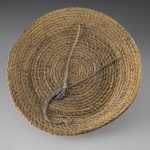By Professor Tiffany Banks On Tuesday, September 30th , students from my COMM 108: Foundations…

Today’s session was devoted to the history of rice cultivation in the United States. Kinshasha Holman Conwill, Deputy Director of the National Museum of African American History & Culture (NMAAHC) began the meeting, and set the tone for the afternoon with a poem aptly chosen for the occasion. She then turned the afternoon over to Christopher Williams, STEM Education Specialist, NMAAHC.
What followed was the story of how enslaved West Africans used their indigenous knowledge and technology to turn rice into the first globally exported grain from the United States. Prior to the slave trade era, rice cultivation had evolved over generations in Africa. Fellows learned the different demands of cultivation in tidal areas such as coastal estuaries and freshwater floodplains as compared to inland swamps and marshes and more uplands areas. Each had its own specific labor and cultivation demands and varied in productivity. What did this history provide? A knowledge system that was transported across the Atlantic. Slaves brought their knowledge of the requirements of field preparation and irrigation to facilitate crop growth for various environmental conditions, as well as how to process and cook the harvest.

The cultivation of rice in the United States began in South Carolina in the late 17th century and propelled the economy to move from subsistence farming to having an exportable crop in only a few decades. Rice cultivation spread geographically, including northward to North Carolina and southward to Georgia and the northern reaches of Florida. This economic boom served to perpetuate the institution of slavery, while also having damaging effects on the environment.
Christopher also covered the emergence of a distinct culture and language, that of the Gullah, which was first seen in the low country region of South Carolina. The Gullah are also known for their sweetgrass baskets. The construction of these baskets is rooted in African basketry, giving us yet another example of cultural knowledge brought across the ocean by African slaves. While often used as decorative items today, these were essential tools for rice farming. Today, the livelihood of

the Gullah people is being threatened. Along with farming, traditionally much of their survival depended on the sea and fishing. Warmer waters and stronger coastal storms have led to fewer fish and shellfish which has created an economic threat. Climate change has also hastened land erosion. Additionally, development has brought tourists to the area, leading to overfishing of dwindling supplies and clearing of land for luxury homes. This has worked to further erode claims of land ownership most of which has been based on having been passed down from generation to generation, often in the absence of a written record. Efforts to protect the language, the land and the unique culture have been underway for the last few decades.
A brief overview of how the NMAAHC’s design was developed with the environment in mind was shared with the group. It is the only museum on the mall to have received gold certification by the U.S. Green Building Council’s Leadership in Energy and Environmental Design (LEED) program.
The afternoon ended with a sharing of a number of resources, including links to the Smithsonian’s Earth Optimism initiative.





This Post Has 0 Comments